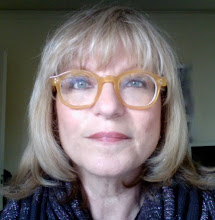Studio Raspail in Montparnasse
So faced with a gray and rainy day, we decided to take a three hour walking tour.
A modernist architectural real estate group has put together a series of parcours, walking tours through parts of Paris that have a particularly large accumulation of 20th century architecture. Today's tour was of artists' ateliers in the 14th arrondissement, an area that includes Montparnasse in the north of the arrondissement and Montsouris, a bit farther south.
You probably know that these areas attracted artists and writers like flies in the years just after World War I. Paris was an incredibly cheap place for Americans to live and when Russians and others from the east fled revolutions and pogroms they too often came to Paris to share studio space, models and the occasional bottle of wine. And the native French were no slouches when it came to the louche life. It was a time of change and one of the things that changed was architecture.
This building is allegedly one of the first to be built by developers specifically targeting the artist market. It has studio windows, partly in fixed decorated glass, with doors in clear glass. These face north for the light. this building was quickly inhabited not by painters but by F. Scott Fitzgerald, Isadora Duncan and Ernest Hemingway. Here's a detail of the metalwork. It's clear what attracted them.
These buildings, like the Studio Raspail in the first photograph above, didn't come out of nowhere. Paris has a tradition of Beaux Arts ornamentation and classic family apartment layouts, many of them from the mid-19th century, when Baron Haussmann tore down the medieval, easily barricaded narrow streets and built hundreds of bourgeois apartment buldings along broad boulevards on which the army could easily maneuver.
Between those buildings and these, were years of transitional ones, like this apartment building on rue Campagne-Première, with its ceramic tile facade and double height atelier windows.
Pretty amazing, isn't it? The ornamentation is still there, but rather than curly Art Nouveau vines, we see stylized flowers in straight lines, circles, triangles and rectangles. The studio windows were huge, the interiors were lofts with mezzanines, and it was cutting edge for the time. Again, this building was so cool that it attracted much higher end inhabitants than the artists living in tiny rooms in the Istria Hotel next door. That hostelry, by the way, has been renovated and shed any vestige of its history as a lodging for Man Ray and Kiki de Montparnasse, among others.
Down the street a bit is this building, rather dilapidated even a hundred years ago, and more reasonable for a working artist. In fact Giorgio de Chirico lived here in the '20s, we were told.
Mallet-Stevens courtyard facade
In the midst of an undistinguished block of '70s apartment houses and vacant lots is one of the prizes of this tour, a building designed and built by architect Robert Mallet-Stevens. The street facade of this building is an odd mixture of ordinary 19th century windows over an entry that screams 1930s.
The front door and the round side windows set into a streamlined stone facade lead through the front building into this courtyard.
More striking architectural stained glass is on the right, above the awning. See that double height studio on the left? It once belonged to artist Tamara de Lempicka, one of the most streamlined of them all. It's now on the market for 4.5 million euros, someone told me. Here's a closer look at the streetside window.
We moved on from the Montparnasse area to a less familiar part of town, close to the Parc Montsouris. This was a ten minute hike in the rain through a generally nondescript area, although I was pulled here and there by interesting looking buildings that I didn't have time to explore. Our tour leader was setting a rapid pace and wasn't waiting for stragglers to catch up before going on with her spiel.
A series of small and extremely charming streets awaited us. Unlike Montparnasse, the Montsouris area has a number of private houses set on private streets. Developed in the '20s and '30s, many of these were designed and some built by well-known architects for well-known clients. These artists were by no means starving.
Nor are the present day owners, some of whom have built in-fill buildings that are as interesting as their neighbors had been in their day.
One of the prizes in this area was the first le Corbusier house built in Paris, a small private residence for his friend, the painter Amedée Ozenfant, which takes advantage of its corner location to place studio windows on two sides.
The street leading away from it is far from clean-lined and modern.
And if Corbusier had known he'd have this for a neighbor he might have left town.
And while plantings can cover a multitude of sins, it can also obscure masterpieces. All you can see of Georges Braque's 1927 house and studio by Auguste and Gustave Perret is this:
The edges of Braque's Cubism are rather softened here. Oh, and I can't help wondering about the frères Perret: which one of them got to be called Gus?




















3 comments:
Shelli, what a delightful vicarious architectural tour! Your photos made me feel like we were right there with you.
Okay...break my heart!! I thought I was the only one who toured modernist Paris. Envy isn't pretty, so I'll try and contain myself...great pix!!
I was feeling rather like a drowned rat by the time it was over, but it was worth it. Patrick, your envy is justified. If you come visit you'll get the personalized tour.
Post a Comment